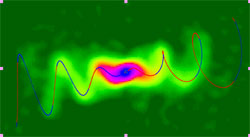Posted: 27 October 2006
Oxford and UCD collaborate to understand motion and acceleration in plasma jets
Most astronomical objects emit radio waves. This emission may not be visible to the naked human eye, but astronomers have been developing ways to make pictures from the radio waves emitted by astronomical objects since 1932. Using radio telescopes, along with x-ray and optical observations, astronomers can capture clear pictures of stars and galaxies.
Pictures developed from radio telescope observations have shown that many galaxies emit extended balloons or lobes of radiation. And it has subsequently been discovered that these radiation balloons result from jets of magnetised plasma consisting of charged particles which travel at close to the speed of light. We also know that these charged particles lose energy as they travel through the magnetic fields. But what we are yet to understand is how these particles lose energy or how they are transported over vast distances in space.

Digitial image of the astrophysical jet from micrquasar SS433
A new collaborative research project between St John’s College, Oxford and University College Dublin aims to investigate some of the fundamental questions surrounding this source of energy in the universe. The research project will be uniquely interdisciplinary; drawing on the fields of observational astronomy, theoretical physics, computational science and developments in transport theory for terrestrial, nuclear fusion plasmas.
Theoretical and computational models developed by research scientists in UCD and Oxford will be compared with data gleaned from astronomical observations. The UCD team will concentrate on theoretical work on the microphysics scale and the Oxford team will focus on observations and modelling on the macro-scale.
Dr Peter Duffy from the UCD School of Mathematical Sciences will lead the UCD research team consisting of two postdoctoral researchers, Dr Stephen O’Sullivan and Dr Joni Tammi, and two PhD students, Mr Brian Reville and Mr Alex Byrne. Two other members of Dr Duffy’s group, Dr Frank Rieger and Mr Paul Demspey, will also carry out research related, in part, to this project.
“These are fundamental issues in astrophysics” says Dr Duffy. “We are proposing to combine developments in theoretical high energy astrophysics with state-of-the-art radio observations to firmly establish the links and differences between such sources... to alleviate the contradictions between theory and observations.”
The Oxford team will consist of two postdoctoral researchers, Dr Katrien Steenbrugge and Dr Fatallah Alouani Bibi, and two members of staff, Dr Katherine Blundell and Prof James Binney FRS; and their PhD students. Dr Katherine Blundell, an expert in radio astronomy and plasma physics, will lead the Oxford side of the research focusing on observations and modelling on the macro-scale.
A Royal Irish Academy/Royal Society exchange scheme grant has been awarded to the groups to facilitate research visits between Dublin and Oxford.
“The dynamics of jet formation clearly involve both gravity and electromagnetism, but the similarities between jets in systems with radically different scales suggests that the underlying physics is simple,” explains Dr Blundell. “It is nevertheless far from understood.”
